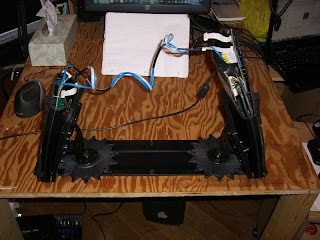I'll spare you the suspense and say up front that it's much faster and seems well worth it. I did some rough measurements of speed on the old and new drives. I measured the time from power on to when the windows 7 login screen is visible, the time when the desktop icons are visible, and then click chrome as soon as I could and got the time when the chrome window appeared (before it showed any pages). These were done with a stopwatch and there will be a little variation based on how long it took me to type my password or click.
Ye Olde Drive:
Login screen 1:43
Desktop 2:53
Chrome 3:22
Yeah I know it's insanely slow to start up. Once it gets going it's plenty snappy. When I first installed windows it was much faster, but all the crap I've installed since then has bogged it down and I don't feel like spending the time reinstalling since I almost never restart.
Then I did the copy to the new disk. It involved shrinking the partition which may have affected the speeds. I booted up twice so it could install the new disk drivers, run scan disk, and get some stuff into the 4GB SSD portion of the disk. On the 3rd boot I measured:
Login screen: 1:13
Desktop 1:44
I didn't click chrome fast enough on this boot so I did it again:
Login screen: 0:57
Desktop 1:20
Chrome 1:29
Holy gajoly! I'm up and running in 44% of the time!
But the variation between the too runs was interesting so I did it once more:
Login screen 1:01
Desktop 1:30
Chrome 1:43
I got a little slower. I assume this has to do with what the disk decides to put in the SSD portion although I only made one baseline measurement on the old disk so I don't really know how much variation there is without that factor.
If you're interested in the details of how I did the copy this time, here they are:
- Connected old and new drive to a linux machine (ubuntu).
- Shrunk system partition on old disk so it would fit on new one using gparted.
- Copied utility and system partitions to new disk. Grew system partition on new disk to use all available space.
- Set utility partition as hidden and system partition as bootable.
- Put new disk in laptop. The plugging in mechanics on the Thinkpad X61 don't work well. It probably took me 10 minutes of plugging in the disk, trying to boot, taking it out and adjusting something until the machine happily detected the disk.
- Booted windows 7 install disk and clicked repair. It detected some boot settings needing fixing so I let it do that and restarted. The drive didn't boot yet.
- Booted install disk again, went to repair, command prompt, and used bootrec /fixmbr and /fixboot (http://support.microsoft.com/kb/927392).
- It booted! Windows had to install some drivers and reboot. On the next boot it did a full scan disk.
- I don't seem to be able to boot the utility partition, but I pretty much never need it so I decided not to worry about that.







